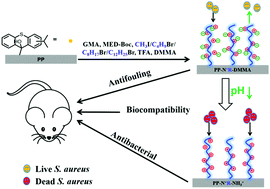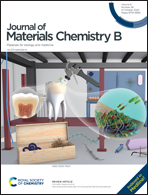pH responsive zwitterionic-to-cationic transition for safe self-defensive antibacterial application†
Abstract
Bacteria-induced infections have always been associated with various medical devices. The construction of an intelligent antimicrobial surface is an important challenge. In this study, we report the construction of a zwitterionic surface with good biocompatibility under physiological conditions and which shows an anti-adhesion effect on the original bacteria. Once the bacteria multiply, the acidic environment initiated by the bacteria will cause the amide bond on the surface to break, and the zwitterionic surface can be rapidly converted to a cationic bactericidal surface. Confocal laser scanning (CLSM) and scanning electron microscopy (SEM) show that the zwitterionic surface has efficient antibacterial activity with an anti-adhesion property while the pH-responsive transition to quaternary ammonium compounds with a germicidal surface in the acidic environment of bacterial metabolism aids the activity. Thus, the pH-responsive zwitterionic-to-cationic transition antibacterial design opens up new ideas for the efficient and safe application of cationic bactericides in clinical medical antibacterial materials.



 Please wait while we load your content...
Please wait while we load your content...